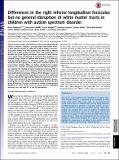Differences in the right inferior longitudinal fasciculus but no general disruption of white matter tracts in children with autism spectrum disorder
Author(s)
Koldewyn, Kami; Yendiki, Anastasia; Weigelt, Sarah; Gweon, Hyowon; Julian, Joshua B.; Richardson, Hilary; Malloy, Caitlin; Saxe, Rebecca R.; Fischl, Bruce; Kanwisher, Nancy; ... Show more Show less
DownloadKoldewyn-2014-Differences in the r.pdf (682.8Kb)
PUBLISHER_POLICY
Publisher Policy
Article is made available in accordance with the publisher's policy and may be subject to US copyright law. Please refer to the publisher's site for terms of use.
Terms of use
Metadata
Show full item recordAbstract
One of the most widely cited features of the neural phenotype of autism is reduced “integrity” of long-range white matter tracts, a claim based primarily on diffusion imaging studies. However, many prior studies have small sample sizes and/or fail to address differences in data quality between those with autism spectrum disorder (ASD) and typical participants, and there is little consensus on which tracts are affected. To overcome these problems, we scanned a large sample of children with autism (n = 52) and typically developing children (n = 73). Data quality was variable, and worse in the ASD group, with some scans unusable because of head motion artifacts. When we follow standard data analysis practices (i.e., without matching head motion between groups), we replicate the finding of lower fractional anisotropy (FA) in multiple white matter tracts. However, when we carefully match data quality between groups, all these effects disappear except in one tract, the right inferior longitudinal fasciculus (ILF). Additional analyses showed the expected developmental increases in the FA of fiber tracts within ASD and typical groups individually, demonstrating that we had sufficient statistical power to detect known group differences. Our data challenge the widely claimed general disruption of white matter tracts in autism, instead implicating only one tract, the right ILF, in the ASD phenotype.
Date issued
2014-02Department
Massachusetts Institute of Technology. Computer Science and Artificial Intelligence Laboratory; Massachusetts Institute of Technology. Department of Brain and Cognitive SciencesJournal
Proceedings of the National Academy of Sciences
Publisher
National Academy of Sciences (U.S.)
Citation
Koldewyn, K., A. Yendiki, S. Weigelt, H. Gweon, J. Julian, H. Richardson, C. Malloy, R. Saxe, B. Fischl, and N. Kanwisher. “Differences in the Right Inferior Longitudinal Fasciculus but No General Disruption of White Matter Tracts in Children with Autism Spectrum Disorder.” Proceedings of the National Academy of Sciences 111, no. 5 (January 21, 2014): 1981–1986.
Version: Final published version
ISSN
0027-8424
1091-6490